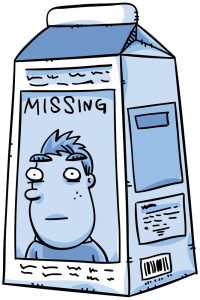The Institute Of Business Forecasting (IBF) defines S&OP as “process that integrates demand, supply, and financial planning into one game plan for business.” It also “links strategic plans to operational plans, and attempts to develop the most desirable product portfolio and product mix to maximize sales and profit.”
The Challenge
Call it by any name. S&OP, SIOP, IBP or IBM, the basic framework remains the same. And S&OP, instead of being an end to end business capability, has evolved into purely a supply chain capability. After 30 + years of S&OP we still don’t see the involvement of Sales people in the S&OP process in most organizations. They are reluctant participants at best, and are not seen at any S&OP seminars or conferences, nor will you see them writing blogs or posts on LinkedIn groups. This lack of engagement is what is holding back S&OP from its full potential.

Has anybody seen the Sales department?
The Real World
Most organizations start S&OP from a purely operational perspective. It is mostly initiated by the head of Operations. In fact, if you go back to the roots of S&OP, it was created to be a process that led the master schedule. Studies have shown that in most S&OP implementations, the process owners are typically heads of supply chain.
I once had the good fortune of having two sales managers attend a presentation I made at an S&OP conference. I started the session by asking the audience how many were from the Sales & Marketing side of the business and, being sure that nobody was going to raise their hand, this was my way of showing that Sales were missing from the S&OP process. To my surprise, I had 2 hands go up. I requested them to stand up and asked the audience to give them a big round of applause. This was a rare sight and something to be cherished.
I do not see Sales people coming to S&OP conferences if we are going to be talking about and showing off our technical systems and processes.
The two sessions after mine were on Artificial Intelligence and Demand Driven forecasting – very technical content totally focusing on the Tools and capabilities to improve demand forecasting. Guess what happened when we returned after lunch? The two Sales guys have gone missing. We scared them away by talking about complicated new fangled technology that had nothing to do with their jobs or objectives.
If we cannot get Sales involved, we may as well remove the “S” from S&OP and add it to our supply chain processes.
I do not see sales people coming to S&OP conferences if we are going to be talking about, and showing off, our technical systems and processes. S&OP is a great process but it continues to suffer from being a supply chain focused process. If we cannot get Sales involved, we may as well remove the “S” from S&OP and call it by any other name and add it to our supply chain processes.
Four Pillars to build the S&OP Process
To successfully build the S&OP process with the full commitment of the Sales and Marketing team, it is important that we address these four areas. These help deliver a collaborative process that benefits every department.
Top Management Support
The most important thing about S&OP is bringing Sales and Operations together in charting the future of the company and this can be done only by the person to whom both report. Without the commitment of the most senior executive, the S&OP process will fail. It is important to ensure that all meeting requests are sent out well in advance and all S&OP Executive Meetings are chaired by the CEO.
The beauty of S&OP are the soft benefits which come early on. Sell soft benefits to the CEO and he will be all ears, this gets him motivated and keeps him engaged. When results appear, he’ll wants to attend all Executive meetings.
Consistency & Discipline
Consistency in meetings and discipline are the framework of a robust S&OP process. Consistency is the difference between failure and success as it enables measurement, creates accountability and reinforces the message.
Fixed agendas for the meeting communicated well in advance facilitate the discipline required for these meetings. Without a fixed agenda and discipline, the meetings will soon be unproductive – people wander off topic and participants spend more time digressing than discussing. Stick to the agenda!
Transparency In Data sharing & Agile Decision Making
Transparency in S&OP data, measurement metrics and the feedback loop enables higher trust levels among participants.
In S&OP meetings, success is often determined by the ability to be quick on your feet and react to changing scenarios. It is very critical that each person in the S&OP meeting has the authority and is empowered to take decisions when required.
Follow-up actions from every meeting need to be properly documented and communicated to all stakeholders
Once the Demand Forecast is agreed on by S&OP stakeholders, any discussions on forecast accuracy should be on what WE got right, what did WE miss, and how do WE improve the process. The discussion should not be on what the demand team forecasted and placing blame.
Trust
S&OP is a collaborative process. Collaboration happens when participants trust eachother. An open, trusting attitude is a must for success. Every participant must believe that they all share a common goal, and everyone else is doing their best for the common success of the team.
In most companies, the S&OP leader is either from the Sales or the Operations team. The biggest boost to trust levels can be brought about by having the S&OP leader report to the CEO.


